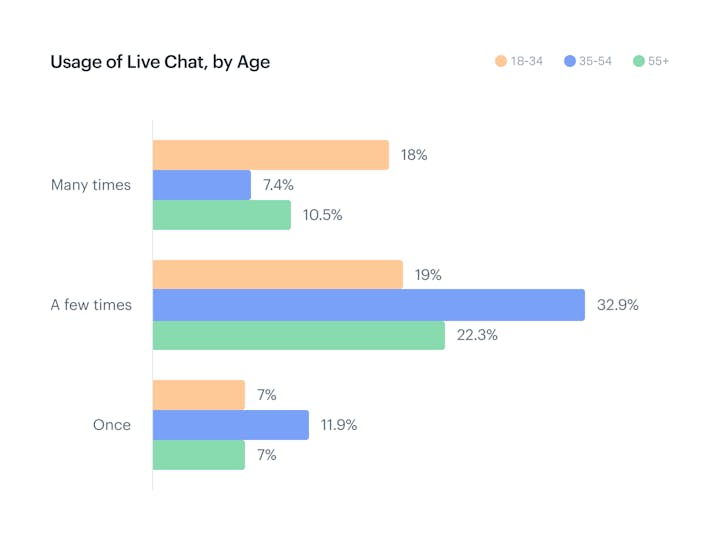21 Key Live Chat Statistics for Customer Service Teams


Some customers just want to call you, while others prefer email or even social media. Over the last few years, though, live chat has consistently been the top support channel of choice, with 41% of consumers preferring live chat support over any other channel.
It’s simple enough to pop a live chat widget on your website and "turn on chat support," but it’s a much larger effort to deliver consistently high-quality customer service through live chat.
Giving great live chat support can demand more time and attention than other channels, so it’s important to understand the balance between the effort and the value.
In this article, we share 21 live chat statistics that explore the value of live chat support to help you build a strong case for investing the time and effort required to make it really work.
This is a chapter in our Ultimate Guide to Live Chat Support. When you're ready, check out the other chapters:
Chapter 1 – Live Chat Support 101: Definition, Benefits, and Best Practices
Chapter 2 – Key Live Chat Statistics for Customer Service Teams
Chapter 3 – How to Implement Live Chat With a Small Support Team
Chapter 4 – The Big Benefits of Live Chat for Customer Service Teams
Chapter 5 – Important Live Chat Tips for Email Support Pros
Chapter 6 – Live Chat Examples for the Entire Customer Journey
Chapter 7 – The Best Live Chat Tools for Customer Support
Chapter 8 – 5 Reasons Why Every Ecommerce Store Needs Live Chat
Chapter 9 – Live Chat Best Practices and Common Mistakes
Chapter 10 – Why Contextual Support is Critical to Live Chat
Chapter 11 – Why You Don’t Need an AI Support Chatbot
Chapter 12 – Actionable Live Chat Metrics to Start Tracking Today
Live chat creates more satisfied customers
The data is clear: given a choice, the typical customer will choose a real-time support option, like phone or chat support, over email or social channels.
This makes sense intuitively; who wants to wait for an answer if they can get one immediately? Embedded live chat support means people can stay in the flow of their task rather than shuffling off to make a phone call or send an email and wait for a reply.
Customers also report being more satisfied with completed live chat support interactions. According to data from Zendesk, customer satisfaction ratings for live chat (85%) are second only to phone support (91%), beating out help center articles (83%), email support (82%), Twitter support (81%), and Facebook support (74%).
Take a look at this data from Statista, showing global customer satisfaction rates with live chat usage compared to data from ASCI, showing overall customer satisfaction rates. Live chat satisfaction rates are higher across every industry.

Key customer preference statistics
1. 41% of consumers prefer live chat support, versus 32% who prefer phone support, 23% who prefer email support, and 3% who prefer getting support via social media. (Source)
2. Live chat has the second-highest customer satisfaction ratings at 85%, just behind phone support at 91%. (Source)
3. The average customer satisfaction rating for live chat globally is 83.1%. (Source)
4. 51% of consumers are more likely to stay with or buy again from a company if they offer live chat support. (Source)
5. 20% of the shopping population prefers using live chat to contact a retailer over any other communication method. (Source)
More speed isn’t always essential
In its 2020 Live Chat Benchmark Report, Comm100 reviewed more than 56 million live chats and determined that the average wait time between a customer submitting a live chat request and the first agent response was 46 seconds.
At a glance, that seems high, but Comm100 also found that organizations with higher wait times tended to have higher customer satisfaction ratings than those with lower wait times.
What’s happening there? Most likely, the companies who are taking a little longer to respond are also providing higher-quality answers. A top-quality answer delivered within a minute or two will beat a too-fast, unhelpful response every time.
Responsiveness is vital in live chat support, but you don’t have to provide an instant answer in order to create great support experiences. People don't mind waiting a little longer for high-quality support, regardless of which channel they use to ask questions.
Key support responsiveness statistics
6. 73% of customers say that valuing their time is the most important thing companies can do to provide them with good customer service. (Source)
7. The average wait time for live chat support is 46 seconds. (Source)
8. Organizations with higher wait times tend to have higher customer satisfaction ratings. (Source)
Chat is a chance to really converse with your customers
The same Comm100 report found that companies with satisfaction ratings above 90% had an average chat duration of 11 minutes and 47 seconds. Those with lower scores had an average chat duration of 8 minutes and 42 seconds.
Depending on your support experience, that may sound like a long time; isn’t live chat about short, quick answers? Well yes, but not exclusively. Live chat is an opportunity for you to have a 10 or 15 minute conversation in real time that might have taken days over email.
You don’t necessarily need to aim for the shortest possible service interactions in order to create truly satisfied customers.
Key resolution time statistics
9. 95% of customers value thorough, high-quality support more than speed. (Source)
10. Companies with satisfaction ratings above 90% have longer live chat durations at an average of 11 minutes and 47 seconds (versus 8 minutes and 42 seconds for sub-90% ratings). (Source)
11. 95% of people say they would prefer slower support if it meant the quality of help was higher. (Source)
Chatbots and self-service are about fast help
For many companies, true AI-answers-my-customers chatbot technology just isn’t a practical option for real customer service yet. For much larger companies, with bigger budgets and sets of training data, there are cases where it can work well.
Comm100 found that conversations fully handled by chatbots received slightly higher satisfaction ratings (87.58%) than those that had to be transferred to a live support agent after a chatbot couldn't answer the question (85.8%).
That finding may be more about the irritation of being transferred than about the bots, of course. In fact, 29% of customers are frustrated by scripted, impersonal responses in live chat.
Another way to help customers get answers quickly is with high-quality self-service materials. A live chat tool which is tightly integrated with a comprehensive knowledge base like Help Scout's Beacon can create a compelling support experience.
Key AI and chatbot statistics
12. Live chats that are fully handled by chatbots receive slightly higher satisfaction ratings (87.58%) than those that have to be transferred to a live support agent (85.8%). (Source)
13. 29% of customers are frustrated by scripted, impersonal responses in live chat. (Source)
Live chat can help you sell more
Being able to talk to someone right when they need to make a decision can really help customers complete a task or a transaction. According to research from Forrester, "69% of U.S. online adults shop more with retailers that offer consistent customer service both online and offline."
People are less willing to pick up a phone to ask a question when shopping online. Even as far back as 2010, 44% of online consumers said that "having questions answered by a live person while in the middle of an online purchase is one of the most important features a website can offer."
Another study found that 40% of buyers who had used live chat were more likely to make online purchases (versus 22% of buyers who had never chatted), and that 38% of buyers reported making their purchase due to the chat itself.
Key sales channel statistics
14. 53% of customers are likely to abandon their online purchases if they can't find quick answers to their questions. (Source)
15. 69% of U.S. online adults shop more with retailers that offer consistent customer service both online and offline. (Source)
16. 40% of buyers who use live chat are more likely to make online purchases (versus 22% of buyers who had never chatted). (Source)
17. 44% of online consumers say that "having questions answered by a live person while in the middle of an online purchase is one of the most important features a website can offer. (Source)
18. 79% of businesses say that offering live chat has had a positive effect on sales, revenue, and customer loyalty. (Source)
Live chat isn’t just a young customer’s game
One persistent belief about live chat is that Millennials and Gen Z are the only ones who want it. However, a survey from Software Advice found that live chat usage spans all age groups:

While it is true that individuals in the 18-34 age group were more likely to have used live chat "many times," many people aged 35+ reported having used live chat a few times for support.
Key demographic usage statistics
19. While people aged 18-34 are most likely to report having used live chat many times, 32.9% of people aged 35-54 and 22.3% of people age 55+ report having used live chat for support a few times. (Source)
20. In a Zoho study, 43% of companies said they had a better understanding of their customers within a year of using live chat. (Source)
21. Live chat is a popular channel for B2B businesses. 61% of B2B businesses report offering live chat, versus only 33% of B2C businesses. (Source)
Tips for adding live chat as a support channel
Once you've gotten the buy-in for adding live chat support, the next step is rolling it out. Here are our best tips for adding live chat to your customer service mix:
You don't have to offer live chat everywhere to every customer. Carefully consider where the unique benefits of live chat will make the most impact. Perhaps your VIP customers will love chat as a unique option for them, or your sales team will love to talk live with new prospects.
You don't have to offer live chat support 24/7/365. Start off by setting your live chat hours to an achievable level, and make those hours clearly visible so that customers know when to expect an answer.
Remember that live chat isn't the right channel for every question. Sometimes conversations will be much easier on the phone or over email. Gracefully transitioning customers between channels is much easier if you integrate live chat with your help desk to automatically create support emails from chat interactions.
Let your support folks focus on one channel at once. It can be very difficult for support professionals to bounce between chat and other support channels like email and phone, especially if they are handling two or three simultaneous chats.
Consider assigning a dedicated live chat employee or having your team rotate that duty to avoid burnout and ensure there’s ample time to meet other support team needs that require deeper focus.
Make your website or app more helpful
Beacon lets you suggest relevant help content, offer live chat, and give customers instant access to their support history — all without leaving your site.
Try for freeLive chat is here to stay
More and more business is being conducted online, and customer expectations about the responsiveness and availability of support will continue to rise.
The real-time conversations you'll have with your customers and prospects over live chat give you an incredible opportunity to understand them better, serve them faster, and build a human connection.
The Supportive Weekly: A newsletter for people who want to deliver exceptional customer service.


